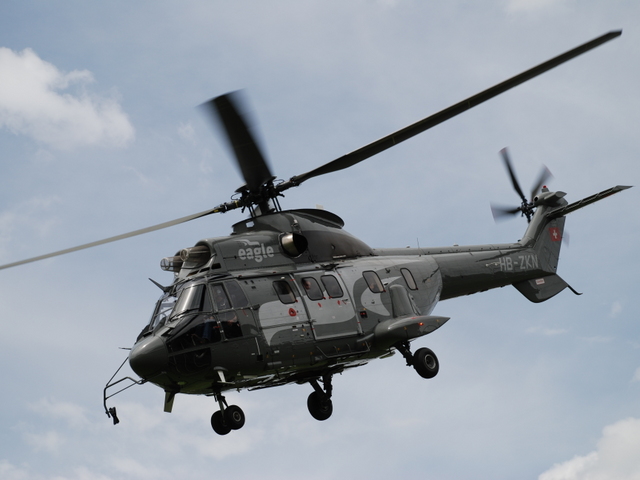Skycore Aviation resumes its series of articles on the family of Super Puma helicopters, this time examining the Eurocopter AS332 which was later re-designated as the Airbus H215 Super Puma.
AS332 / H215 Super Puma
The AS332 Super Puma was introduced in 1990, built to succeed the SA330 Puma as a medium weight utility helicopter able to support multiple mission needs. Its large cabin, lift capability and power reserves support civil and para-public uses. The AS332 has been extremely popular from its inception and between July 1981 and April 1987 there was an average production rate of 3 helicopters per month being built for both civil and military customers. By 2005, the Super Puma (in different variants) was operated by 38 different nations. In 2014 with the renaming of Eurocopter to Airbus, the AS332 was also renamed as the Airbus H215 Super Puma.
In 1990, the military Super Puma designation was changed from AS332 to AS532 Cougar to distinguish between the civil and military variants. Airbus markets their version of the AS532 as the H215M Cougar which is in use by NATO and many militaries in Europe and throughout the world. Skycore will feature the Cougar in an upcoming article in this series.
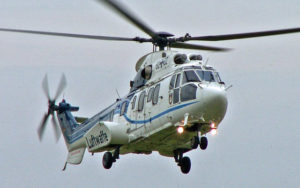
The Luftwaffe, German aerial warfare branch of the military, flying an AS332L1 Super Puma
Super Puma Enhancements and Components
The power of the Super Puma was significantly enhanced by replacing the Turbomeca Turmo engines with Turbomeca Makila 1A1 turboshaft engines. The new engines drive the Super Puma’s four-bladed main rotor and five-bladed tail rotor, a pair of electrical alternators and separate hydraulic systems. As a result, sling load lift capability was increased by 80% for a maximum lift of 9,920 lbs.
The overall length of the Super Puma increased almost 2 feet from the SA330 with space added to the cabin to provide seating for up to 3 additional passengers or additional cargo. The current H215 is available in two versions, one configured for multi-role operations and the second built with a shorter cabin airframe. From a safety perspective, the Super Puma adopted a new crashworthy undercarriage, transmission deck, cockpit flow and composite rotor blades able to withstand a level of battle damage.
The helicopter’s fuselage structure houses 6 internal fuel tanks with the ability to add auxiliary and external tanks for extended flight endurance. The Super Puma’s monocoque tail boom is fitted with tail rotor strike protection and a retractable tricycle landing gear designed for high energy absorption. The Super Puma’s main landing gear features a trailing arm design, while the nose landing gear has a caster wheel.
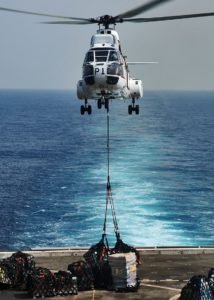
An AS332 Super Puma helicopter delivers cargo
Super Puma Major Variants
The AS332L1 is a stretched civil version of the Super Puma with a long fuselage and an airline interior for personnel transport. As with utility helicopters built for multiple roles, mission equipment enhances operational capability. The mission equipment designed to support offshore utility transport for the AS332L1 are as follows.
- Single action door release
- Push out cabin windows
- HEELS exit lighting kit
- Wireless public address
- Air conditioning
- Floats completion
- Cargo hook provisions
- Hoist utility
- Sling
- Deployment system for flotation
- Life raft deployment system
- Sound proofing upholstery
- Ambulance fixed parts
- Automatic deployable Emergency Location Transmitter (ADELT)
The AS332C1e Super Puma variant is designed to perform combat search-and-rescue (CSAR), search-and-rescue (SAR), as well as maritime surveillance operations. It’s a versatile utility helicopter that can also be configured for law enforcement, peace-keeping, public security, drug trafficking, humanitarian deployments, passenger transport, utility airlift, MedEvac and firefighting missions. The AS332C1e cockpit is integrated with a Sextant Avionique NADIR MK2 self-contained, autonomous navigation system, multifunction LCD displays, dual flight control, and a SFIM 155 supermode-capable autopilot system with higher order modes. A Thomson-CIF CLIO FLIR sighting system is fitted for SAR operations during night time. The helicopter is equipped with a Bendix 1500B radar for the detection of small boats at long ranges and also features a Spectrolab searchlight and loud hailers.
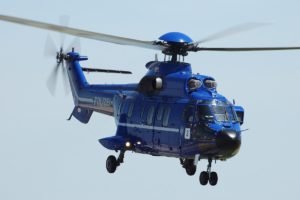
An AS332L1 on a law enforcement mission
Operational History of the Super Puma
The Super Puma has performed well in various civil missions such as utility, aerial work, search and rescue (SAR), and public service. The Super Puma external takeoff weight of more than 20,000 lbs. provides the power needed for heavy loads. The increased lift capability for sling loads further supports its utility role. Large main cabin sliding doors allow easy loading and unloading of bulky freight, while the helicopter’s rear access eases the handling of long loads.
The Super Puma has incurred problems with its main gear box which coupled by improper maintenance and inspection procedures was fatal. As a result, Airbus made design and material improvements to the Super Puma to address fatigue failure and increase reliability. These changes include replacing parts in gearbox with more resistance, reducing its life limit from 4,000 to 1,000 flight hours, an enhanced anti-spalling system and a strengthened inspection criteria, along with equipment allowing a more detailed analysis of particles.
The Super Puma is also used as a VIP aircraft for heads of state. The Brazilian Air Force uses two Super Pumas to transport the President of Brazil using the designation V-34. These main presidential helicopters have been configured to carry up to fifteen passengers and three crew members
Militaries around the world use the Super Puma today. The Royal Saudi Navy has 20 in its fleet. Argentina uses Super Pumas to fly transport missions while Chile flies 7 for SAR and anti-submarine warfare (ASW). Many countries have purchased the C1 variant. In 1998, the Greek Merchant Marine purchased AS332C1 Super Puma helicopters for surveillance and SAR missions and in late 2000 the Greek Air Force purchased four helicopters for CSAR and SAR. The Bolivian Air Force also ordered 6 AS332C1e helicopters in 2014 to fight drug trafficking and perform other civil security and public service duties across the country. Airbus has also established manufacturing of the Super Puma in Romania.
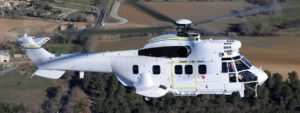
A Romanian AS332C1e
Skycore Aviation is an international helicopter personnel services company. Our knowledge and experience enables us to provide personnel and turnkey solutions for helicopter programs tailored to meet our customer’s operations, maintenance and training needs. To stay atop of the rotary wing industry, subscribe to receive helicopter news and follow us on Twitter, LinkedIn or Facebook.

